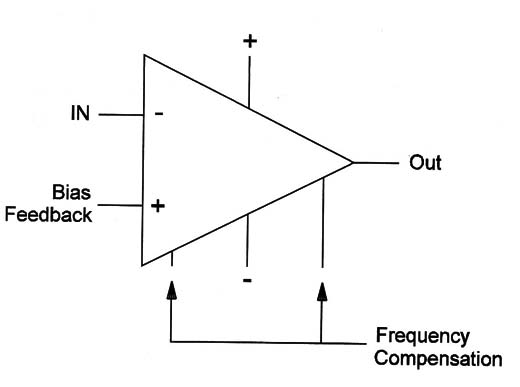The high-value capacitors necessary to many of the stages are connected to the circuit by external pins. In many cases, the manufacturers can use the circuit with a minimum of external capacitors.
Many audio amplifiers can have resources to program the gain or the frequency response by some external components. In the simplest types we have an input where the volume control is placed, an output where loudspeaker or headphones/earphones are connected, the power supply pins, and some other necessary parts, such as capacitors (coupling and decoupling) and resistors (to program gain).
Many manufacturers have types containing two amplifiers in one case, making the project of stereo equipment easier.
Modern circuits using Class-D configurations reduce the number and the value of external capacitors. These Ics are used in commercial amplifiers and other applications requiring low number of components.
Symbol and Example
Figure 1 shows the basic symbol adopted to represent an audio amplifier. The cases are SIL or DIL or another type based on the output power.

Specifications
The le of this group are also identified by a part number according to the manufacturer. The electric specifications of an audio amplifier in the form of an integrated circuit are the same for any other audio amplifier.
A. Output power-the amount of power that the circuit can drive to a loudspeaker. It is indicated in watts (W) and in some cases abbreviated by Po or Pout.
B. Power supply voltages and current-important when designing the power supply for the circuit. It is given in volts.
C. Output impedance-characteristics of the loudspeakers/earphones connected to the output of any audio amplifier are very important to not overload. Impedance is given in Ω and typically is between 2 and 16 Ω for types designed to drive loudspeakers and higher for earphone/headphones amplifiers.
D. Input impedance-given in Ω.
E. Gain-how many times the amplitude in volts of the output signal is higher than the amplitude of the input signal. This specification is important for the input impedance to determine the sensitivity of an amplifier.
F. Operation curves and other specifications-performance of an audio amplifier according to the signal frequency is given by curves. These response curves show how the fidelity of an amplifier is when working with signals of the audio spectrum. These specifications are important when making a project. For the technician who needs information to find a replacement, the part number is enough. It is important to call the reader’s attention to the fact that amplifiers with the same power in the cases can be different in disposition of pins and the external components meaning that they are not interchangeable.
Where they are found
Audio amplifiers are found in every part and a large quantity of common AC-powered appliances, embedded in electric installations, or even powered from batteries, but all related to applications in the electric installation. For instance, intercoms, alarms, doorbells, wireless telephones, wireless intercoms, baby monitors, and ambient sound sources can use an audio amplifier (or several) in the form of an integrated circuit to drive an earphone or one or more loudspeakers.
When creating the equipment the designer must instead use a dedicated integrated circuit where all the functions are embedded in a unique device and can use some common integrated circuits in some functions as the audio output.
Testing
The best way to test a common integrated circuit, such as an audio amplifier, is by measuring the voltages in their pins. It is recommended to do this measurement only after verifying if the associated components (external capacitors, resistors, etc.) are good. For this, it is important to have an idea about the magnitude of voltages to be found or to have the schematic diagram of the equipment where the voltages are indicated.



